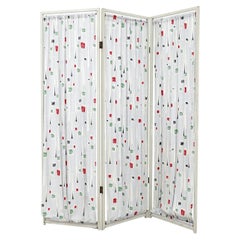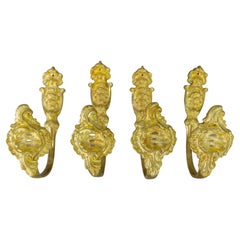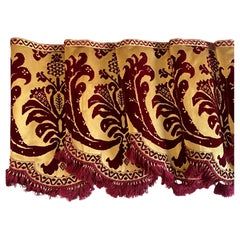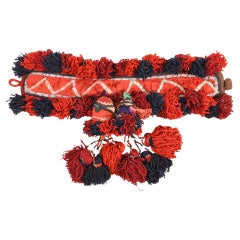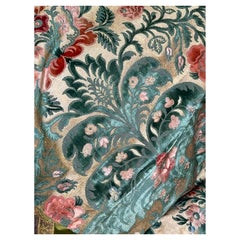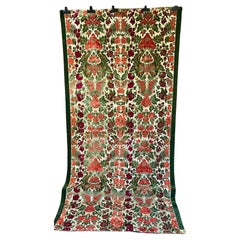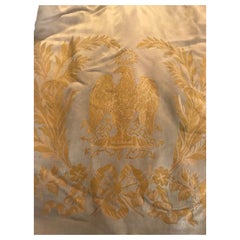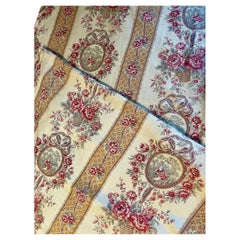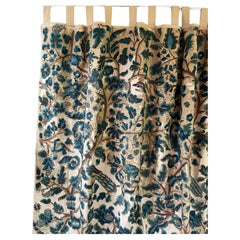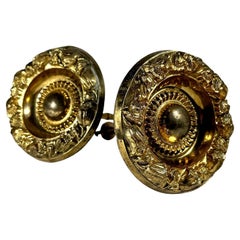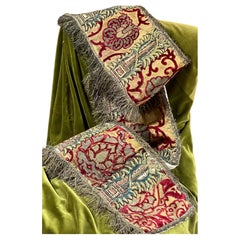Curtains and Valances
Early 17th Century Antique Curtains and Valances
Silk, Velvet
Early 1800s French Empire Antique Curtains and Valances
Textile
19th Century French French Provincial Antique Curtains and Valances
Cotton
Mid-17th Century Jacobean Antique Curtains and Valances
Wool, Linen
Late 19th Century American Federal Antique Curtains and Valances
Brass
16th Century Italian Renaissance Antique Curtains and Valances
Metallic Thread
2010s Curtains and Valances
Cotton, Linen
2010s Moroccan Arts and Crafts Curtains and Valances
Wool
15th Century and Earlier Italian Renaissance Antique Curtains and Valances
Metallic Thread
2010s American Curtains and Valances
Silk
Mid-20th Century Italian Renaissance Curtains and Valances
Silk
2010s Moroccan Arts and Crafts Curtains and Valances
Wool
Early 1800s British Arts and Crafts Antique Curtains and Valances
Wool, Linen
1950s Swedish Scandinavian Modern Vintage Curtains and Valances
Linen
21st Century and Contemporary Italian Rococo Curtains and Valances
Metallic Thread
21st Century and Contemporary Italian Rococo Curtains and Valances
Metallic Thread
21st Century and Contemporary British Curtains and Valances
Velvet, Polyester
1970s Vintage Curtains and Valances
Fabric
Early 1600s Italian Renaissance Antique Curtains and Valances
Silk
Late 19th Century American Victorian Antique Curtains and Valances
Velvet
17th Century English Jacobean Antique Curtains and Valances
Wool, Cotton
Mid-20th Century American Mid-Century Modern Curtains and Valances
Textile
Early 2000s American Modern Curtains and Valances
Cotton, Linen
19th Century French Baroque Antique Curtains and Valances
Metallic Thread
1960s French Mid-Century Modern Vintage Curtains and Valances
Silk, Beads
21st Century and Contemporary American Curtains and Valances
Textile
17th Century Italian Renaissance Antique Curtains and Valances
Linen, Silk
Late 19th Century American Victorian Antique Curtains and Valances
Velvet
Mid-20th Century Italian Arts and Crafts Curtains and Valances
Metallic Thread
21st Century and Contemporary Moroccan Curtains and Valances
Leather
Late 18th Century French Empire Antique Curtains and Valances
Velvet
Early 2000s Italian Modern Curtains and Valances
Cotton
19th Century French Baroque Antique Curtains and Valances
Silk, Velvet
1970s Swiss Space Age Vintage Curtains and Valances
Fabric, Cotton
16th Century Italian Renaissance Antique Curtains and Valances
Metallic Thread
1960s American Mid-Century Modern Vintage Curtains and Valances
Silk
Late 20th Century American Mission Curtains and Valances
Textile
20th Century Curtains and Valances
Silk
Mid-19th Century Uzbek Suzani Antique Curtains and Valances
Silk
Late 20th Century Indian Curtains and Valances
Silk
15th Century and Earlier South American Pre-Columbian Antique Curtains and Valances
Wool
Early 20th Century Spanish Curtains and Valances
Wood
Late 20th Century Art Deco Curtains and Valances
Cotton
Early 2000s Modern Curtains and Valances
Cotton, Linen
17th Century British Charles II Antique Curtains and Valances
Linen, Silk
16th Century Italian Renaissance Antique Curtains and Valances
Metallic Thread
1750s French Rococo Antique Curtains and Valances
Cotton
1950s Dutch Mid-Century Modern Vintage Curtains and Valances
Metal
Late 20th Century French Aubusson Curtains and Valances
Wool, Cotton, Acrylic
1930s Dutch Art Deco Vintage Curtains and Valances
Velvet
1980s English Louis XV Vintage Curtains and Valances
Cotton
Late 18th Century Italian Belle Époque Antique Curtains and Valances
Metallic Thread
Early 2000s Italian Modern Curtains and Valances
Cotton
1850s English Gothic Revival Antique Curtains and Valances
Gold
1920s English Louis XV Vintage Curtains and Valances
Silk
Late 20th Century Italian Curtains and Valances
Damask
15th Century and Earlier Egyptian Archaistic Antique Curtains and Valances
Wood, Wool
1890s Italian Baroque Antique Curtains and Valances
Cotton, Silk, Velvet
Mid-20th Century American Mid-Century Modern Curtains and Valances
Linen
Mid-19th Century French Antique Curtains and Valances
Giltwood
Antique and Vintage Curtains and Valances for Sale: Shop Velvet Curtains, Victorian Curtains and Other Textiles on 1stDibs
From luxe drapes in sumptuous hues to airy shades crafted from natural bamboo, window treatments have become a hot topic. The right antique and vintage curtains and valances can change and improve the feel and mood of any room in your home.
Window treatments such as curtains and valances serve multiple functions: filtering light, maintaining privacy and injecting personality. Like furniture, they have the ability to transform and elevate a room. And while it takes work to seamlessly integrate window treatments with the surrounding decor, it will be worth the effort!
Designer Brigette Romanek, whose notable clients include Beyoncé and Gwyneth Paltrow, believes that the perfect window treatment blends usability with aesthetics. That mix is elegantly exemplified in this dual-use Los Angeles living room. “In the daytime, you can pull the drapes and let all that light in and enjoy the incredible view," explains Romanek. "This space is also a media room, and the blinds do a great job of blacking out the room for weekend afternoon movie marathons.”
A firm believer in the power of window dressings, Starrett Ringbom puts a lot of thought into choosing just the right type and design. Just as lighting is an essential part of any interior design project — having the right light fixture is indeed key to creating an attractive, radiant room — a well-chosen pair of curtains or well-placed window valance can make all the difference. Regardless of their appearance, though, window dressings must work with the existing architecture. As Ringbom puts it, “Window treatments are a vital component of any room design.”
Frances Merrill, of Reath Design, sympathizes with those struggling to find the right dressing for their windows. “Curtains are so hard! The window treatment and the fabric used can make such a difference in how light moves through a room.”
On 1stDibs, the collection of antique and vintage curtains and valances for sale includes velvet curtains, mid-century curtains featuring interesting prints and other textiles for your space.
